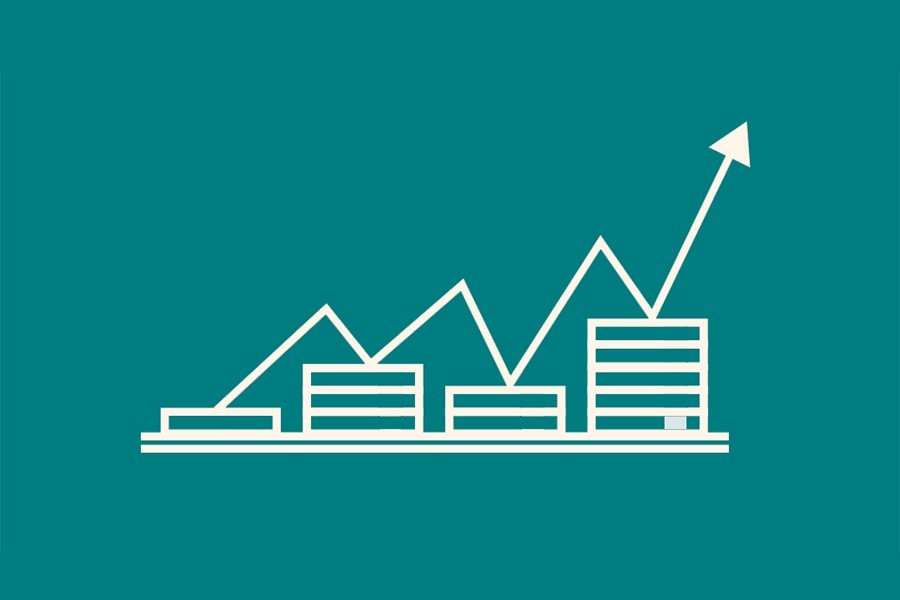There was a moderate rise in nominal wage of low-paid skilled and unskilled workers in the country in the past year. Wages Rate Index (WRI), released by the Bangladesh Bureau of Statistics (BBS) early this month, showed that National WRI stood at 170.34 in December last year which was 159.89 in December 2018. Thus, WRI increased by 6.54 per cent on point-to-point basis during the period under review.
The annual average WRI, however, recorded at 165.31 in 2019 which was 155.24 in 2018 - an increase by 6.49 per cent in the past year. Again, annual average WRI was 146 in 2017 and recorded 6.34 per cent growth in 2018. The trend indicates that there is a consistent rise in nominal wages of low-paid workers.
According to BBS, the index aims to measure the 'movement of nominal wages of low-paid skilled and unskilled labour' over time in agriculture, industry and service. 11 occupations from agriculture, 22 occupations from industry and 11 occupations from service sector are included in the index. Besides sector-based WRI, there are divisional WRI for seven divisions of the country to get a more detailed picture of nominal wages in different parts of the country.
The national statistical agency defines nominal wages as the 'amount of money received either in cash or in kind in a day for standard daily working hours or earnings of low-paid labour.' These labourers usually work on hourly basis and are considered as wage- earners for the index. BBS doesn't include 'salary paid and high contract-based earnings' in the index.
Increase of nominal wage doesn't mean that labourers are earning enough. Nominal wage is the money wage as it is generally received by a worker in the form of money or cash. Real wages is the purchasing power of money earned as nominal wages.
BBS has stopped estimating real wages since 2007. It is not clear why the national statistical agency has stopped the exercise which is an important tool to gauge the pattern of economic development. In the absence of real wages indicator, a number of proxy indicators may be used to check whether there is an erosion of real wages or not.
Rate of inflation is the most relevant tool to examine the status of real wages. Usually, nominal wage rate adjusted with corresponding inflation rate provides real wages rate for a particular period of time. In the absence of official estimate, it is difficult to understand what would be the real wages index. As annual average inflation rate was 5.59 per cent in 2019, adjusting it with annual average 6.49 per cent growth of WRI shows that there is 0.90 percentage point rise in real wages. It is apparently a simplistic calculation; nevertheless, it shows that the country's low-paid workers have very little at their hands due to erosion of real wages. The real wages is increasing at a snail's pace as cost of living is rising at a faster pace.
Adjusting the inflation rate with the interest rate of bank deposit is another proxy indicator. Weighted average deposit rate of all the banks stood at 5.71 per cent in November last year when monthly inflation rate was 6.05 per cent. Thus real earnings from banks' interest on deposit actually turned negative as there was a reduction of 0.34 percentage point. It indicates that by keeping their hard-earned income in banks as savings, depositors are losing in real terms. The higher rate of inflation against lower rate of deposit is an unfair burden on fixed-income people.
The Sustainable Development Goals (SDGs), endorsed by the United Nations (UN), has put emphasis on protecting the real wages of people to reduce inequality. Goal-10 asks to 'reduce inequality within and among countries.' Target 10.4 under the goal envisages adoption of 'policies, especially fiscal, wages and social protection policies, and progressively achieve greater equality.'
Bangladesh has no dedicated wage policy, although there is a labour policy, which is mostly a broad guideline to deal with labour-related issues emphasising on labour rights and labour welfare. The policy also provides a brief guideline on fixing 'just wages'. It mentions that the government would make arrangement for just wages so that labourers and their families could maintain an acceptable standard of living. The policy outlines a number of steps to determine wages by including the benchmark of minimum wages and regular review and re-fixation of wages in line with market price.
The labour policy, however, doesn't explicitly say anything about the protection of real wage. Thus, a revised labour policy having appropriate emphasis on real wage is the need of the hour. BBS also needs to reintroduce real wages index which will help gauge the so-called trickled-down effect of higher economic growth.
When the country's Gross Domestic Product (GDP) has registered 8-plus growth in FY19, very slow progress in real wages of low-paid workers indicates widening disparity in income and expenditure. Overall ratio of private consumption to GDP dropped to 68.71 per cent in FY19 from 70.81 per cent in FY18 which also indicates that real wages of low-paid workers have been adversely affected.
In his budget speech, placed in the national parliament in June last year, the finance minister didn't mention anything about the status of real wages. This is not in line with the Seventh Five-Year Plan (7FYP), which gives due importance to real wages arguing that 'growth in employment, labour productivity and real wages' constitutes the three 'most important factors for sustainable reduction in poverty'.


